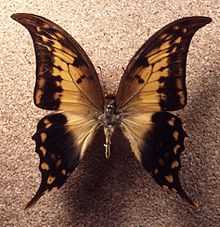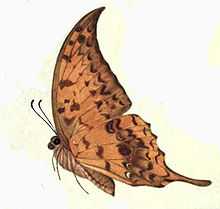Meandrusa payeni
| Yellow Gorgon | |
|---|---|
 | |
| Scientific classification | |
| Kingdom: | Animalia |
| Phylum: | Arthropoda |
| Class: | Insecta |
| Order: | Lepidoptera |
| Family: | Papilionidae |
| Genus: | Meandrusa |
| Species: | M. payeni |
| Binomial name | |
| Meandrusa payeni Boisduval, 1836 | |
| Synonyms | |
|
Papilio evan Doubleday, 1845 | |
The Yellow Gorgon (Meandrusa payeni) is a species of swallowtail found in parts of South Asia and Southeast Asia. It belongs to the Hooked Swallowtails genus, Meandrusa, of the Papilionidae family. They are also called Outlet Sword or The Sickle.
Description
- For terms used in the description see Lepidopteran terminology
Male

Upperside bright ochraceous, with a darker shade towards the base of the wings. Fore wing: two or three spots obliquely across the cell, a larger spot at its upper apex, the costal margin from base (the collar broadened towards the apex), and the terminal margin very broadly, dark brown; on the inner side of this broad brown terminal edging there is a transverse incomplete discal series of dark brown spots, followed by an irregular transverse series of brown lunules, both these merge anteriorly and posteriorly into the brown on the termen; lastly superposed on the brown terminal edging is a more or less complete, transverse, subterminal series of lunules of the ochraceous ground-colour, reduced in some specimens to only two or three lunules above the tornus. Hind wing: terminal half or more dark brown, with an inner postdiscal and an outer subterminal series of more or less lunular spots of the ochraceous ground-colour; the postdiscal series consists of only four spots in interspaces 1 to 4, the subterminal series is complete to interspace 7, the spots larger, that in inter-apace 3 elongate, outwardly conical; tail tipped with ochraceous. underside: ground-colour a deeper richer ochraceous. Fore wing:cell and basal area with a number of irregular cinnamon-brown spots, followed on the terminal half by three transverse series of more or less irregular and incomplete lunular cinnamon-brown markings and a narrow brown terminal edging. Hind wing: basal area with a transverse series of three spots, a large spot at apex of cell, the bases of interspaces 1, 2 and 3, followed by three more or less complete but irregular series of lunular markings, cinnamon-brown; superposed on the inner discal row of brown lunules is a transverse series of snow-white crescents, conspicuous only in interspaces 1 and 2, but barely indicated anteriorly. Antenna dark ochraceous brown; head, thorax and abdomen ochraceous, the thorax posteriorly and basal half of the abdomen olivaceous; beneath: head, thorax and abdomen brighter ochraceous.[1]
Female
Ground-colour paler, base and cell of fore wing on upperside shaded with bright very pale cinnamon; markings similar both on the upper and under sides, but less clearly defined; the costal margin of fore wing on the upperside ochraceous almost to apex, not brown; the subterminal series of ochraceous lunules on the upperside of the hind wing very large, separated from one another only by the brown along the veins. Antennae, head, thorax and abdomen similar, but paler.[1]
Distribution
The butterfly is found in India from Sikkim to Assam, North Burma and Peninsular Malaysia
Status
The Yellow Gorgon is not threatened, but, not common across most of its range. However it is considered to be Vulnerable and in need of protection in Peninsular Malaysia.[2]
Cited references
- ↑ 1.0 1.1 Bingham, C. T. 1907. Fauna of British India. Butterflies. Volume 2.
- ↑ Collins, N.M. & Morris, M.G. (1985) Threatened Swallowtail Butterflies of the World. IUCN. ISBN 2-88032-603-6